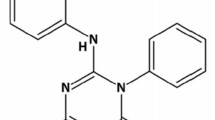Abstract
Unusual serum profiles of phenprobamate, a centrally skeletal muscle relaxant, were observed in Sprague Dawley rats receiving multiple doses of phenprobamate suspension. The concentrations of phenprobamate were higher after the morning doses than after the evening doses, synchronizing with the day–night pattern of drug administration. Crossover studies were conducted to investigate the apparent time-dependent kinetics of phenprobamate. Phenprobamate emulsion was orally administered as a single dose to a group of six rats at 0900 hr and again, after a washout period of 3 days, at 2100 hr. Another group of six rats was treated similarly with intraperitoneal drug administration. Blood samples were collected at various times for 12 hr. The AUCs were 146.56 ± 31.77 µg · hr/ml for the morning oral dose and 111.31 ± 21.32 µg · hr/ml for the evening oral dose (P < 0.001). Administered intraperitoneally, the AUCs were 179.89 ± 37.50 and 185.58 ± 28.51 µg · hr/ml for the morning and evening doses, respectively, the difference of which was not significant. The paired t test indicated a significant morning–evening difference in AUC following oral but not intraperitoneal drug administration. This suggests the absorption rather than metabolism as a contributing factor to the time-dependent kinetics of phenprobamate in rats.
Similar content being viewed by others
REFERENCES
J. Clench, A. Reinberg, Z. Dziewanowska, J. Ghata, and M. H. Smolensky. Eur. J. Clin. Pharmacol. 20:359–369 (1981).
K. G. Maxey, M. H. Smolensky, and J. P. Mcgovern. In A. Reinberg and F. Halberg (eds.), Chronopharmacology, Pergamon Press, Oxford, 1979, pp. 239–244.
D. S. Minors and J. M. Waterhouse. Chronobiologia 7:465–480 (1979).
D. Hollander, M. Kielb, and E. Rim. Am. J. Digest. Dis. 23:1125–1128 (1978).
J. Wobel and G. Nagel. Experimentia 35:1581–1582 (1979).
P. Kabasakalian, M. Katz, B. Rosenkrantz, and E. Townley. J. Pharm. Sci. 59:595–600 (1970).
M. B. Kathe. Aerzliche Praxis 43:2385–2388 (1961).
M. Kuriyama and K. Okada. Eisei Kagaku 11:176–180 (1965).
F. Schatz and U. Jahn. Arzneimittel-Forsch. 16:866–870 (1966).
E. A. Swinyard and W. Lowenthal. In A. R. Gennaro (eds.), Remington's Pharmaceutical Sciences, Mack, Pa., 1985, p. 1296.
J. X. S. Sun, K. Embil, D. S. C. Chow, and C. S. Lee. Biopharm. Drug Dispos. 8:341–351 (1987).
J. G. Wagner and E. Nelson. J. Pharm. Sci. 53:1392–1403 (1964).
Pharmaceutical Research Press.
K. J. Ho. Am. J. Physiol. 230:1331–1335 (1976).
K. J. Ho and J. L. Drummond. Am. J. Physiol. 299:1427–1437 (1975).
K. J. Ho. J. Lipid Res. 17:600–604 (1976).
Author information
Authors and Affiliations
Rights and permissions
About this article
Cite this article
Sun, J.XS., Embil, K. & Lee, CS.C. Time-Dependent Absorption of Phenprobamate Following Multiple Dosing in Rats. Pharm Res 5, 387–390 (1988). https://doi.org/10.1023/A:1015967829826
Issue Date:
DOI: https://doi.org/10.1023/A:1015967829826




